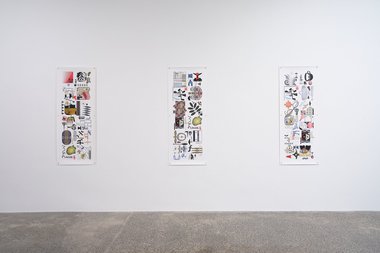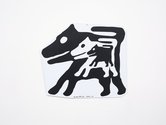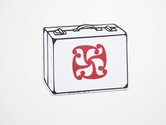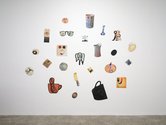John Hurrell – 10 August, 2024
Most of these codifying images are either carrying utensils like jars, bottles, baskets, tools, books, aircraft, and animals such as pets, livestock, birds or insects. Sometimes separated body parts like heads are included, or repeated geometric patterns, or within contours fragments of alien shapes inserted or added on. Their different scales suggest different distances away from the viewer. Most are frontal but others are at oblique angles, and if human figures are included, retreating away from the picture-plane.
In this show, Richard Killeen is presenting individual motifs deliberately crammed together on ten new vertical grommeted bands of canvas: six strips in a large size, four in a smaller. There is also an eighties ‘cut-out’ of grouped shaped images at the far end of the gallery, and a couple of small (particularly evocative) rectangular solo panels.
Of the vertical canvas works, one’s initial response is to ponder the role of density and proximity on these collected assorted Killeen images: their impact on interaction; the effect also of the narrow rectangular support they are presented on-the proportions of the canvas strips; the stacked layering or hybridity within each contained unit; its facing alignment; the fixed nature of its position in relation to the rest of the group; and, if you really wanted to speculate about function in language: what ‘part of speech’ each image might be.
Most of these codifying images are either carrying utensils like jars, bottles, baskets, tools, books, aircraft, and animals such as pets, livestock, birds or insects. Sometimes separated body parts like heads are included, or repeated geometric patterns, or within contours fragments of alien shapes inserted or added on. Their different scales suggest different distances away from the viewer. Most are frontal but others are at oblique angles, and if human figures are included, retreating away from the picture-plane.
Odd questions arise, such as is each exhibited collection a sample, or is the collection of collections instead, itself, a sample? Plus ‘assorted images’ allows varied examples to be taken from different periods (and types of style) within Killeen’s ‘cutout’ group and solo image format, and then deliberately regrouped together. Viewer thinking pleasure is then encouraged through the resulting newly postulated narratives and fortuitous formal comparisons, and contrasting modes of representation, or subtleties within properties like shadow, overlapping forms, ambiguity and thickness of edge.
The much wider image collection that these are taken from is found in the artist’s large computer archive of images, appropriated from a wide range of research-friendly sources such as books about ornament or institutional archives. The works are thus intended to whet your appetite; to make you curious about other works Killeen has made, that are referenced through these (now showcased) carefully chosen striking images.
Killeen is clearly having fun with the potential possibilities, for the results are very playful in their sometimes bizarre combinations—avoiding conventional or expected pairings—often going for discordant, ‘outrageous’ or unexpected blendings. In another series, in a dog-shaped work he is referring to Gordon Walters’ en abyme series, possibly also linking it to David Lynch and a motif in some of his films and music.
These digitally-printed and stores artworks are more a type of drawing than painting, being graphic in sensibility, often linear, and revelling in embracing complexity, but not too much. You need to stand pretty close to notice their intricacy of construction and loaded juxtaposition, to then scan and explore.
Wiggling lines and dancing fragments of shape seem liable to cavort across the narrow canvas, disconnecting themselves from the objects Killeen has placed there, especially if they are flat or frontal. I’m not that sure that in his strange spatial mingling of normally separate universes (now exploding and recombining), that the narrative or literal origins of each stylistically particular motif is crucial. I’m more convinced that the evolved hybridity is morphological, not necessarily semantic; a humorous prodding of the artist’s (and [with him] viewer’s) transmuting, and reassembling, kaleidoscopic imagination.
John Hurrell

























 Two Rooms presents a program of residencies and projects
Two Rooms presents a program of residencies and projects Advertising in this column
Advertising in this column



This Discussion has 0 comments.
Comment
Participate
Register to Participate.
Sign in
Sign in to an existing account.